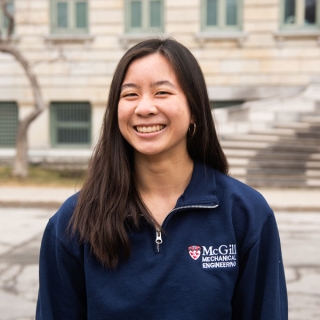The only thing better than two good ideas is to combine them into one great idea.
Engineering students Bernadette Ng and Tirza Pang were eager to join the humanitarian organization Global Brigades on a student trip to build water pipelines in Latin America. But when they learned that all trips were being cancelled due to the COVID pandemic, they set about brainstorming other ways to help rural communities have better access to clean water.
There was already simple technology available for filtering and cleaning water, and there were ways to carry water. But there was “no solution that combined water transportation and water filtration at the same time,” says Ng, a U3 Mechanical Engineering student. Many communities in remote regions need to travel up to two hours to collect water to bring back to their homes, she adds. “Maybe during that time they could already start cleaning the water?”
Members of the McGill BioDesign team, Ng and Pang pitched their idea as an official project for a biotechnology competition and recruited other students to work with them. The resulting SOLar-A backpack project is a great example of the kind of experiential learning that the University encourages.
Devising a solution
Together, the group of mostly Engineering students devised a clear plastic container that could be strapped into a backpack harness. The water is initially cleaned through an activated carbon filter, and then the sun’s ultraviolet (UV) rays deactivate the bacteria and pathogens within. A sensor detects the amount of UV going into the jug and then after a certain amount of time—about four to six hours—the water is ready to drink.
The Kinesiology students on the team helped with the technology that converts the user’s walking motion into energy that powers the sensor. The ultimate goal is to create surplus energy that can be stored for later use.
The team looked into ways for the jug to absorb more heat. “Increasing the temperature can also help increase the efficiency,” she explains. “We’re trying to add an aluminum lining to reflect the rays back into the jug so the rays last a bit longer inside to clean the water.”
They first wanted to devise a 20-litre jug, but one of their mentors, Christopher Nzediegwu, a postdoctoral fellow at University of Alberta and McGill alumnus, used to transport water for his family when he was a kid. “He said 20 litres is heavy!” Ng says. “Especially for a child, or a woman who’s pregnant or is carrying a baby in front.”
Currently, many people use buckets that previously contained chemicals, so the specially designed jugs are definitely preferable for transporting drinking water. The team will set a threshold for how long their jug can be used before the plastic starts to degrade and leach into the water.
Empowering students
This May, seven team members will get to test SOLar-A in the field when they finally travel with Global Brigades to a remote community in Honduras to help with water access. McGill’s impact200 Student Sustainability Challenge is helping fund the travel costs.
Some of the team’s financial support for materials comes from the Faculty of Engineering’s Empower initiative, run by Skills Development Advisor April Babey. “There’s a gap between the skill set that employers want and the skill sets that students have, and that’s what my program addresses,” she says. The office’s Global Challenge Award helps fund projects with social impacts. “It’s whatever the students bring to us—we don’t try to be prescriptive,” Babey says. “What idea do you have that you can do in 12 to 16 weeks in the summer that you need funding for?”
The Empower intiative also supports the UK-based Change the World program, which uses the 17 UN Sustainable Development Goals as part of its framework. For example, this year the office is helping to send a student to Antarctica for research on climate change, and others to Eswatini to build bridges.
Empower also provides a workshop series called Engineer Your Path that encourages students to reflect on what kind of an impact they want to make in the world. “That’s really the spirit of what the program is!” says Babey. “I don’t want to be someone in an office telling students what to do; I want to support them with their own ideas.

Hands-on work
Despite all the technical finessing of the project, Ng says the main challenge was brainstorming online only for a year and half due to the pandemic, before meeting up at McGill. “It’s definitely more fun and motivating when we’re together because that’s when we can actually get to build something together and you can see the faces in front of you. Especially in engineering. You want to do hands-on work, to get your hands dirty,” Ng says.
The kind of experience that Ng had—organizing the group, collaborating at a distance, then delving into the details of solving tech problems—shows resilience and creativity, Babey says. “That’s what experiential learning is all about. The skills of doing stuff, facing real-world challenges that are not in the safety of the classroom where the obstacles are controlled.”
Once the team began meeting in person, the momentum rolled. “As we were seeing results, that pushed us to work at a faster pace,” Ng adds. Team members were able to get loads of feedback from professors, mentors, and people working in the field, which pushed their progress and motivated them to advance the SOlar-A backpack as much as possible before going to Honduras.
“I am very excited to get community feedback in Honduras on our project so we can improve it and bring it to the next level,” says Ng. “And to gain real-world experience on improving water access, which is the problem that first inspired me to study engineering."
This article was originally published in the McGill Channels.
